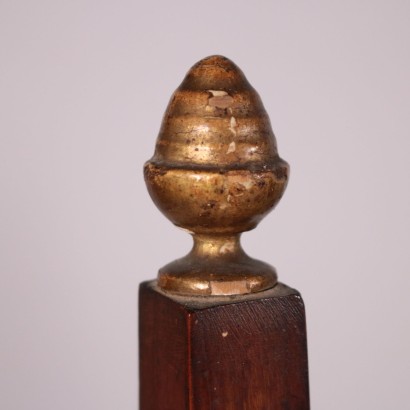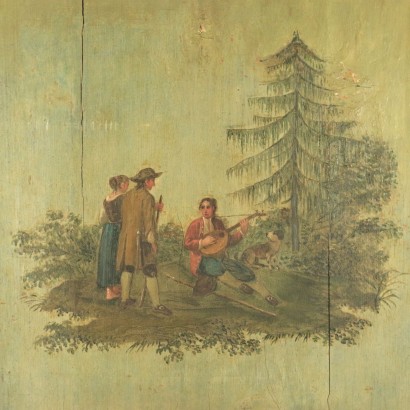Small Walnut Cheval Mirror Empire Style Italy 19th Century
Features
Style: Empire (1804-1815)
Age: 19th Century / 1801 - 1900
Origin: Italy
Main essence: Walnut
Description
Small cheval mirror in Empire style. The mixtilinear base has turned feet and two small drawers. Two pyramidal "obelisques" with gilded turning support the tilting mirror. The frame's mirror is in ebonized wood.
Product Condition:
Fair condition. Wear consistent with age and use.
Dimensions (cm):
Height: 91
Width: 75,5
Depth: 21
With certificate of authenticity
Additional Information
Style: Empire (1804-1815)
Decorative style of the furniture that is affirmed under the Empire of Napoleon Bonaparte, that is, between 1799, the year of his election as consul, and 1815, the year of his definitive defeat.It has many elements of continuity with the previous Direttorio style, in the more general Neoclassical climate, which derived from the study of classical antiquity the forms and models to be inspired in the creation of furniture.
The peculiar feature of this style is a greater grandeur and courtesy of the furnishings, which had to convey the grandeur of the French nation to the world, hence the name Empire style.
The furniture is characterized by straight, majestic and massive lines, adorned with motifs dear to Napoleon such as bees, eagles, large Ns surrounded by laurel, and, after the Egyptian campaign, many elements taken from Egyptian art.
He prefers the flat bronze decorations, often gilded, to the refined carvings of previous years.
The typical essence of Empire furniture is mahogany.
Find out more with our insights:
Classic Monday: How society influences the taste in furnishings
Classic Monday: Empire, one style of furniture with political purposes
Classic Monday: in the Empire bed roots of culture
Classic Monday: the timeless charm of a toilet Empire
Age: 19th Century / 1801 - 1900
19th Century / 1801 - 1900Main essence: Walnut
Walnut wood comes from the plant whose botanical name is juglans regia , probably originally from the East but very common in Europe. Light or dark brown in color, it is a hard wood with a beautiful grain, widely used in antique furniture. It was the main essence in Italy throughout the Renaissance and later had a good diffusion in Europe, especially in England, until the advent of mahogany. It was used for solid wood furniture and sometimes carvings and inlays, its only big limitation is that it suffers a lot from woodworm. In France it was widely used more than anything else in the provinces. In the second half of the eighteenth century its use decreased significantly because mahogany and other exotic woods were preferred. It could also interest you
























